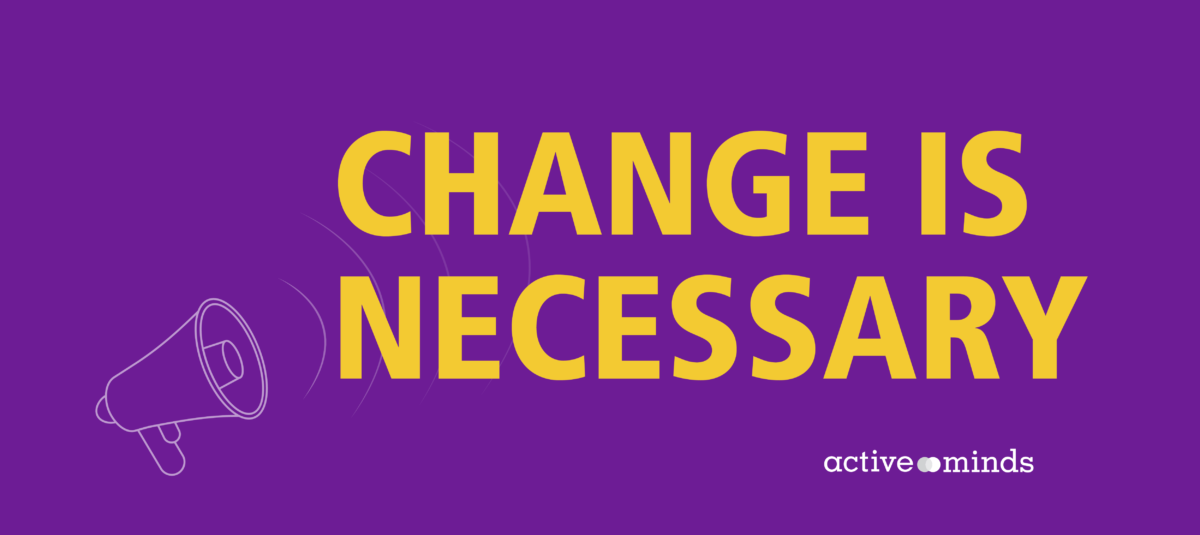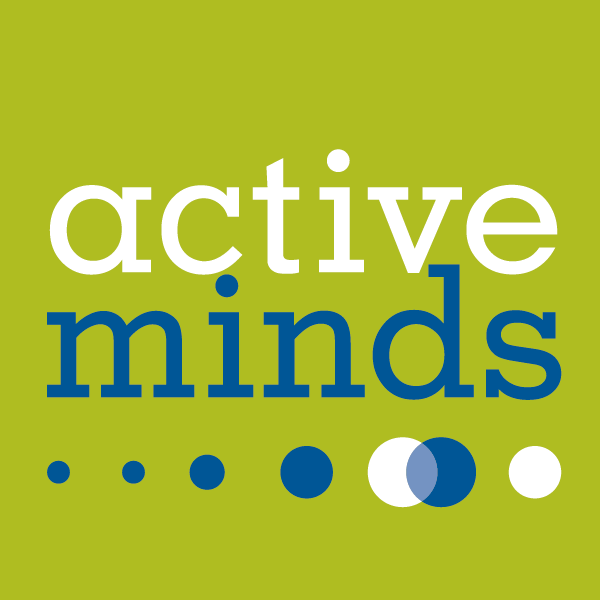Content Warning: This piece contains mentions of suicide statistics.
Active Minds is calling on young adults across the nation to advocate for change and use their voices to establish a campus culture of caring and support for BIPOC students. Here are our recommendations of ways you can begin to make change, starting today.
We launched our Your Voice Is Your Power Campaign to support BIPOC mental health at the start of Suicide Prevention Month – a time many of you returned to campus.
There’s a reason for that. In fact, there are eight.
1. Student mental health needs to be a top priority.
Young adults are a high-risk population for developing mental health challenges. An estimated twenty percent of adult mental health diagnoses occur between the ages of 18 and 24.1
The Healthy Minds Study and the National College Health Assessment show a rising prevalence of depression, anxiety, eating disorders, and suicidality in student populations across the past decade with approximately one in three students meeting the criteria for a clinically significant mental health concern.2 A quarter of full-time students have reported experiencing any mental illness in the past year and almost eight percent of students reported a serious mental health illness.3
Key mental health concerns plaguing college and university students include anxiety, stress, and depression. The 2019 National College Health Assessment conducted by the American College Health Association reports students’ academic performance has been negatively affected by anxiety (27.6%), stress (21.5%), or depression (37.5%).4
2. BIPOC student mental health issues were even more pronounced prior to the pandemic.
Black Americans are twenty percent more likely to experience mental health issues than the rest of the population5, yet the likelihood Black university students will be diagnosed with a mental health condition is statistically significantly lower.7 While Black university students are less likely to meet the criteria for a mental health problem relative to their white peers7, BIPOC student mental health concerns have been rising.
The Healthy Minds Study has seen increases in anxiety and depression among BIPOC students.6 Multiracial students are more likely to meet the criteria for a mental health problem compared to their white peers.7 Indigenous young adults have the highest rate of suicide of any ethnic group.8
3. Experts predict mental health challenges will rise this fall.
COVID-19 has created psychological scars and this will be exacerbated for college and university students as they resume their coursework this fall. One in five college students reported that their mental health has significantly worsened during COVID-19.9 From late March to May 2020, students were experiencing substantial mental health struggles,2 and sixty percent of students indicated it has been more difficult to access mental health services.2
4. Experts predict BIPOC students’ mental health challenges will be exacerbated due to the pandemic, police violence, and racial discrimination.
BIPOC individuals are heavily affected by systemic racism. Systemic racism is a mental health and public health crisis, linked with depression, anxiety, and post-traumatic stress, among other negative impacts.
Throughout the pandemic, BIPOC individuals have faced economic and mental health struggles. The Centers for Disease Control and Prevention has identified social determinants of health that put BIPOC individuals at greater risk of getting sick with COVID-19, including discrimination, healthcare access and utilization, education, income and wealth gaps, occupation, and housing.10
About four in ten Black and Asian adults have attested to having people act uncomfortable around them because of their race and ethnicity since the beginning of the outbreak.11 Almost forty-one percent of college students reported witnessing race-based discrimination since the start of the pandemic, with approximately six percent of students experiencing it.2
5. BIPOC students are less likely to receive mental health support than white students.
BIPOC mental health concerns have been rising prior to the pandemic. BIPOC students generally have lower odds of seeking professional health for mental health concerns as a result of discrimination from healthcare providers, lack of available resources, and stigma associated with seeking professional mental health.5
Approximately half of white college students, compared to less than one-quarter of Black students, have received a mental health diagnosis.7 Black students also have 73% lower odds of being diagnosed with a mental health condition compared to their white peers.7 Many university students identify stigma as one of the main reasons they do not seek support for mental health concerns,12, 13, 14 and this is more pronounced for BIPOC students.7
6. BIPOC students need services that make it easier to get help and increase their access to culturally responsive care.
The COVID pandemic has further illuminated risk factors among BIPOC students that reinforce systemic inequalities. As such, universities have recognized the importance of providing culturally responsive care to BIPOC students. To increase access to services many universities have implemented drop-in sessions with counselors meant for BIPOC students and the use of teletherapy appointments where students can work with therapists from a variety of cultural backgrounds.15
7. Faculty are key facilitators of BIPOC students’ sense of belonging and connection to the university during COVID-19.
Students recognize the valuable contribution of staff during the COVID-19 pandemic. Almost seventy percent of students feel as though their university staff and administration have been supportive during the pandemic and seventy-eight percent identify feeling supported by faculty members.3 With approximately fifty-four percent of Black students, sixty-five percent of Latinx students, and seventy percent of Native American students relying on informal or nonclinical sources of support, it is crucial they can find safety in some university faculty.2,7
To give additional support to BIPOC students, colleges and universities should hire more faculty and staff members with diverse backgrounds. A diverse faculty benefits students by giving them a sense of belonging as well as comfort, and the added security for students in knowing that there is someone at their school or on their campus who understands their culture and the different things about them.16
8. Cultural competency training reduces risk for misunderstandings, microaggressions, and bias.
Campuses have the capacity to create substantial change and many have adopted programming to increase cultural competency among students, faculty, and staff and reduce the risk for misunderstandings, microaggressions, and bias. BIPOC students who have completed the modules addressing the racial injustice crisis have been shown to perform at a higher rate than their white peers.15
The time is now to support and uplift oppressed communities. To learn how you can be a part of this movement and create change, visit: activeminds.org/yourvoice.
References
- Hunt, J., & Eisenberg, D. (2010). Mental health problems and help-seeking behavior among college students. Journal of Adolescent Health, 46(1), 3-10. doi:10.1016/j.jadohealth.2009.08.008
- Healthy Minds Network, & American College Health Association. (2020). The impact of COVID-19 on college student well-being. Retrieved from https://www.acha.org/documents/ncha/Healthy_Minds_NCHA_COVID_Survey_Report_FINAL.pdf
- Substance Abuse and Mental Health Services Administration. (2019). Behavioral Health Among College Students Information & Resource Kit. HHS Publication No. (SMA) 19-5052. Rockville, MD: Substance Abuse and Mental Health Services Administration.
- American College Health Association. (2020). American College Health Association-National College Health Assessment III: Reference Group Executive Summary Fall 2019. Retrieved from https://www.acha.org/NCHA/ACHA-NCHA_Data/Publications_and_Reports/NCHA/Data/Reports_ACHA-NCHAIII.aspx
- National Alliance on Mental Illness. (2020). Identity and Cultural Dimensions: Black/African American. Retrieved from https://www.nami.org/Your-Journey/Identity-and-Cultural-Dimensions/Black-African-American
- Health Minds Network. (2020). Healthy Minds Data. Retrieved from https://healthymindsnetwork.org/research/data-for-researchers/
- Lipson, S. K., Kern, A., Eisenberg, D., & Breland-Noble, A. M. (2018). Mental health disparities among college students of color. Journal of Adolescent Health, 63(3), 348-356. doi.org/10.1016/j.jadohealth.2018.04.014
- Curtin SC & Hedegaard H. 2019. Suicide rates for females and males by race and ethnicity: United States, 1999 and 2017. Retrieved from https://www.cdc.gov/nchs/data/hestat/suicide/rates_1999_2017.htm
- Active Minds. (2020). COVID-19 Impact on College Student Mental Health. Retrieved from https://www.activeminds.org/wp-content/uploads/2020/04/Student-Survey-Infographic.pdf
- Centers for Disease Control and Prevention. (2020). Health Equity Considerations and Racial and Ethnic Minority Groups. Retrieved from https://www.cdc.gov/coronavirus/2019-ncov/community/health-equity/race-ethnicity.html
- Ruiz, N. G., Horowitz, J. M., & Tamir, C. (2020). Many Black and Asian Americans Say They Have Experienced Discrimination Amid COVID-19 Outbreak. Retrieved from https://www.pewsocialtrends.org/2020/07/01/many-black-and-asian-americans-say-they-have-experienced-discrimination-amid-the-covid-19-outbreak/
- Pedersen, E. R., & Paves, A. P. (2014). Comparing perceived public stigma and personal stigma of mental health treatment seeking in a young adult sample. Psychiatry Research, 219(1), 143-150. doi:10.1016/j.psychres.2014.05.017
- Vogel, D. L., Strass, H. A., Heath, P. J., Al-Darmaki, F. R., Armstrong, P. I., Baptista, M. N., . . . Zlati, A. (2017). Stigma of seeking psychological services: Examining college students across ten countries/regions. The Counseling Psychologist, 45(2), 170-192. doi:10.1177/0011000016671411
- Vogel, D. L., Wade, N. G., & Haake, S. (2006). Measuring the self-stigma associated with seeking psychological help. Journal of Counseling Psychology, 53(3), 325-337. doi:10.1037/0022-0167.53.3.325
- Brown, S. (2020). Students of Color Are Not OK. Here’s How Colleges Can Support Them. The Chronicle of Higher Education. Retrieved from https://www.chronicle.com/article/students-of-color-are-not-ok-heres-how-colleges-can-support-them
- Collins, C.J. & Kritsonis, W.A. (2006). National viewpoint: The importance of hiring a diverse faculty. National Journal for Publishing and Mentoring Doctoral Student Research, 3(1).




